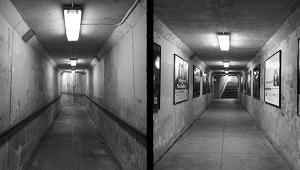The Power Of Black And White
 While every image we make with a digital camera starts out as a color (RGB) image, it doesn’t preclude creating dynamic black-and-white photos from those image files. In fact, the ability to “convert” to color lends itself to producing more tonally rich images than we ever could have imagined when working with black-and-white silver materials.
While every image we make with a digital camera starts out as a color (RGB) image, it doesn’t preclude creating dynamic black-and-white photos from those image files. In fact, the ability to “convert” to color lends itself to producing more tonally rich images than we ever could have imagined when working with black-and-white silver materials.
Each color can be separated and addressed as a tonal value and we can, for example, make “reds” appear as deep tonal values or as bright and high on the tonal scale as we might like. Blue sky can be made to look as pale or as deep as fits the scene, and we can emulate the deep, near-black sky attained by using a deep red filter over the lens when using film simply by sliding a slider in the conversion controls. Numerous software companies have turned their attention to black and white and there are more “presets” and variables available than I ever imagined possible.
Beyond this ability lies the heart of why we might want to work in black and white. While color certainly has its charms, there’s nothing quite like the look and feel of a black-and-white image, one that strips away the “seduction” of color to reduce a portrait, landscape, or still life to its essential nature and form. And to me there’s something inherently “photographic” about black and white, an emotional quality that makes it stand on its own.
In this issue we take a look at work from photographers who have decided to follow the black-and-white path, and as you look at their images you can see why that choice becomes an essential part of what they have to “say” about their particular subject matter. If you look at Phil Pantano’s amazing portraits, try to imagine them in color and you’d have to wonder if their impact would have been as powerful. Gregory Heisler, a master of portraiture, also chose to work in black and white, and his portraits serve as icons of the age. The landscapes of William Davis and the “street” photography of Vivian Maier also owe part of their strength to their monochromic choices.
It used to be that fine black-and-white work was limited by the need to master chemical darkroom techniques. It was all about exposure, film processing, and then careful application of paper choice and hand/light controls when printing. It wasn’t easy. Working in black and white today is simply not as arduous, although of course aesthetics and eye always play an important role, be it film or digital. But the access to black-and-white expression is certainly more accessible than ever. The rewards can be great and the new doors it opens can do wonders for your ability to make expressive and creative images from many of the photographs you have taken. Hopefully this issue starts you on your way, or at the least creates an impetus to give it a try.
Having worked in black and white since I was a kid (lo those many years ago) I have to say we are in the “golden age” of black-and-white creativity, and the possibilities are richer than ever before.


































